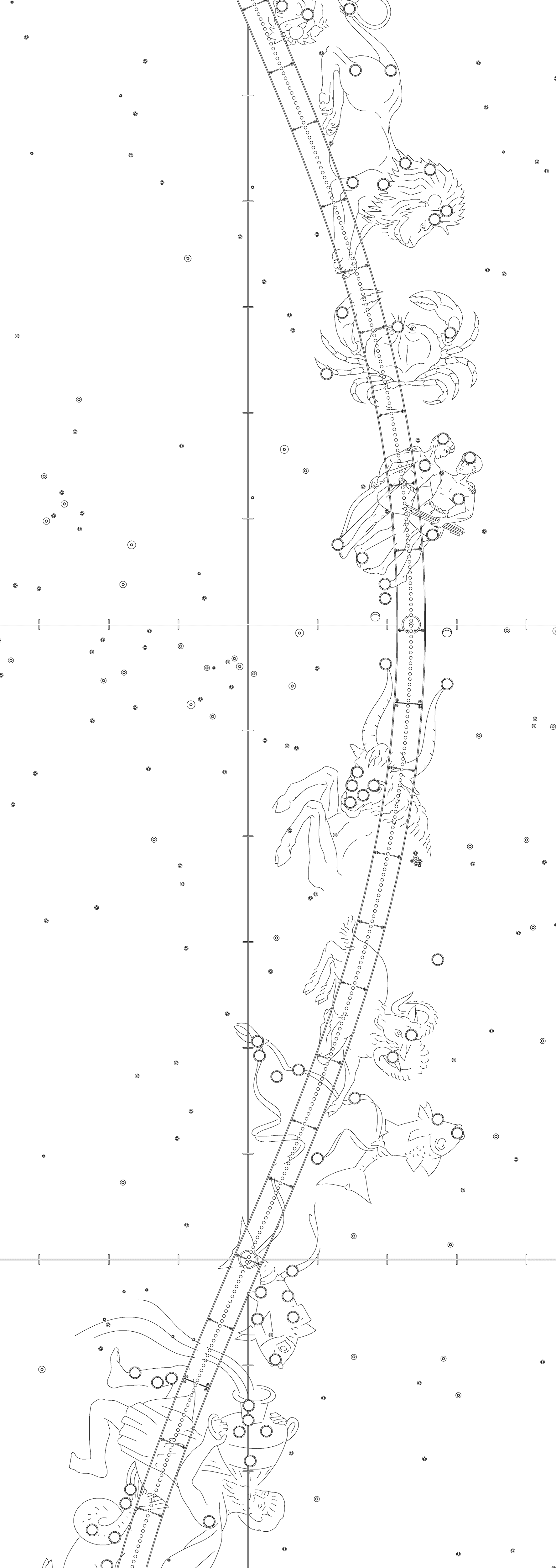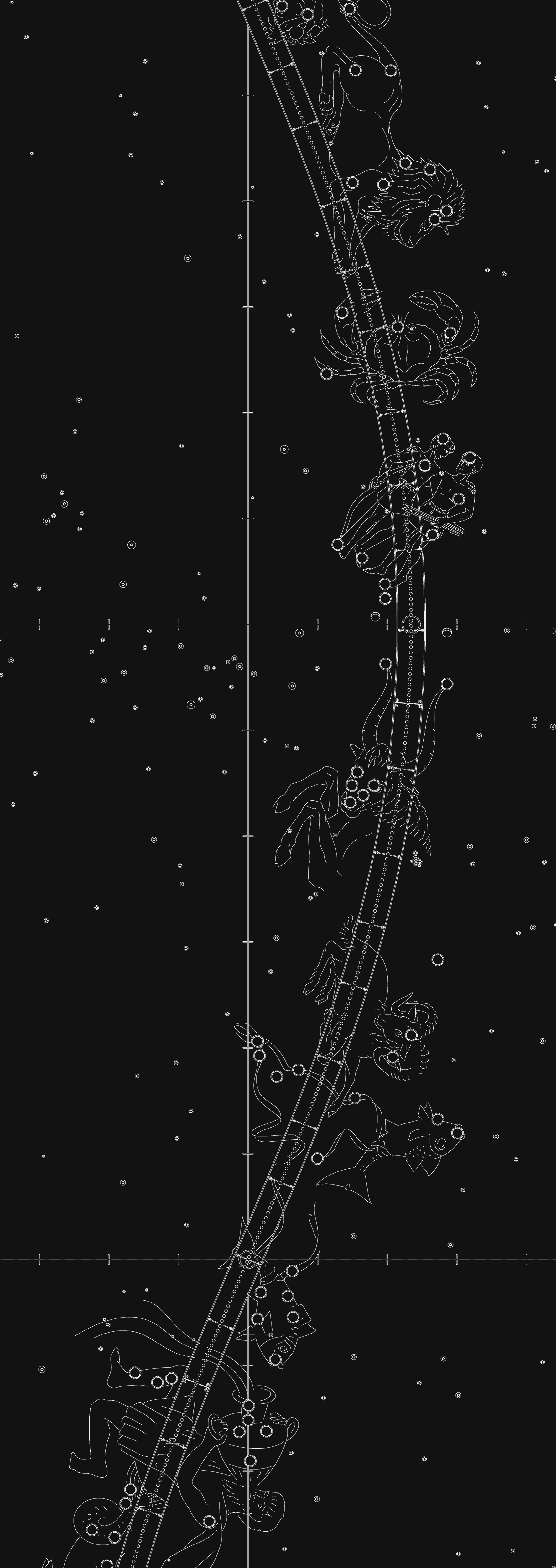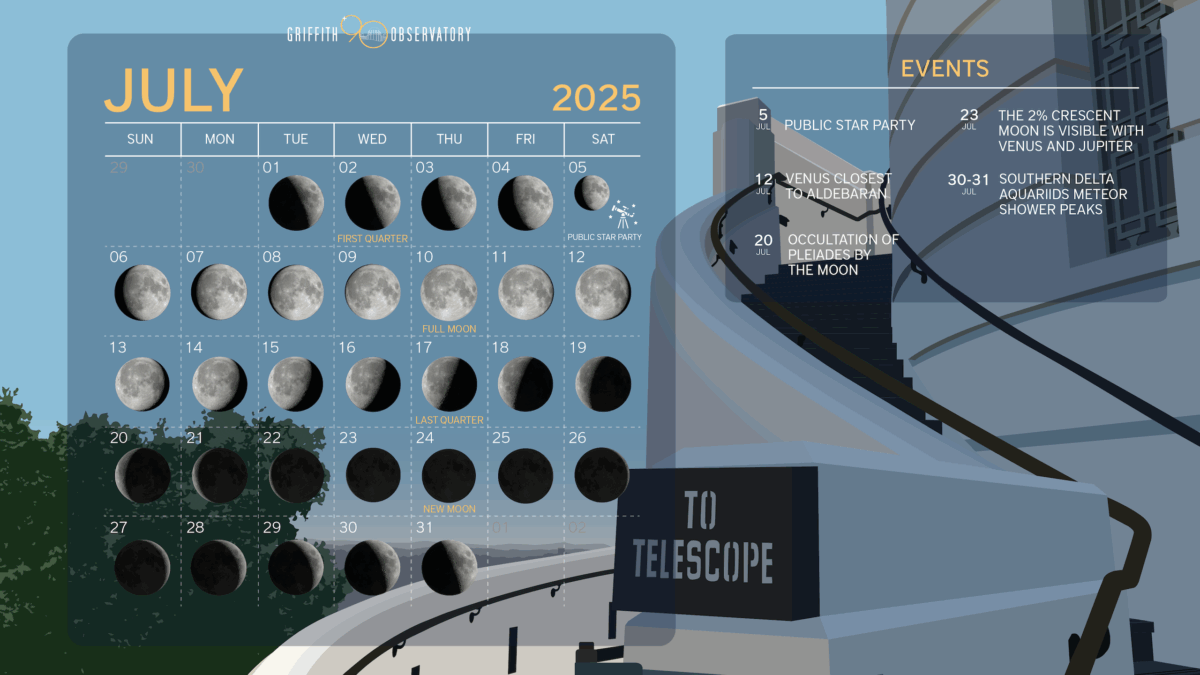Sky Report
This is the monthly Griffith Observatory Sky Report. You may read or listen to it below.



Sky Report
July, 2025
This is the Griffith Observatory Sky Report for the period between July 1 and July 31, 2025. Here are the events happening in the sky of southern California.
All times are in Pacific Daylight Time, PDT.
The sun rises on the 1st in the east-northeast at 5:46 a.m., and sets in the west-northwest at 8:09 p.m. On the 31st, the sun rises in the east-northeast at 6:04 a.m. and sets in the west-northwest at 7:55 p.m.
Mercury on the 1st sets in the west-northwest at 9:44 p.m. with a disk 46-percent illuminated and 7.6 arcseconds wide. On the 17th, the sun sets at 8:04 p.m., and Mercury sets in the west-northwest at 8:56 p.m., 52 minutes later. The planet is 19-percent illuminated and ten arcseconds wide. After the 17th, Mercury is close to the sun, and it is not safe to observe it. Do not observe any planet when it comes close to the sun, for the danger to the eyes is great.
Venus rises on the 1st in the east-northeast at 3:04 a.m., with a disk 64-percent illuminated and 18-arcseconds wide. On the 31st, Venus rises in the east-northeast at 3:11 a.m., with a disk 75-percent illuminated and 14-arcseconds wide.
Mars is in Leo the Lion. On the 1st, Mars sets in the west-northwest at 11:22 p.m., with a disk 92-percent illuminated and 4.9-arcseconds wide. On the 31st, Mars sets in the west at 10:09 p.m., with a disk 94-percent illuminated and 4.4-arcseconds wide. A magnification of 200x or more is needed to see the planet’s disk.
Jupiter is in Gemini the Twins. On the 1st, Jupiter rises in the east-northeast at 5:25 a.m., 21 minutes before the sun rises, and is not safe to observe. Do not observe any planet when it is close to the sun, for the danger to the eyes is great. On the 15th, Jupiter rises in the east-northeast at 4:44 a.m., and the sun rises at 5:53 a.m., one hour nine minutes later. On the 31st, the planet rises at 3:57 a.m. Jupiter is 32-arcseconds wide. A telescope capable of magnification 50x will show the Red Spot, and the four bright Galilean moons can be seen moving back and forth, across and behind Jupiter.
Saturn is in Pisces the Fishes. On the 1st, Saturn rises in the east at 12:26 a.m. On the 31st, the planet rises at 10:24 p.m. Saturn is 18-arcseconds wide. The rings and Saturn’s largest moon, Titan, can be seen with a telescope capable of magnification 50x. Saturn is one degree south of Neptune. Binoculars or a telescope with a magnification of 50x or less will show both planets in the same field of view.
Saturn’s moon Titan will cast its shadow on Saturn’s disk twice this month. Such an event is called a transit. The first transit starts on the 2nd, at 12:23 a.m., and ends at 6:00 a.m. The second transit starts on the 17th at 11:43 p.m., and ends on the 18th at 5:02 a.m. Titan’s shadow is about half an arcsecond in width. A magnification of more than 300x is needed to see such a small feature.
Uranus is in Taurus the Bull. On the 1st, Uranus rises in the east-northeast at 3:05 a.m. On the 31st, Uranus rises at 1:11 a.m. On the 15th, Uranus is at Right Ascension 3h 52m 49s and declination of +20° 0ʹ 51ʺ. A magnification of 200x or more is needed to see the planet’s 3.5-arcsecond disk.
Neptune is in Pisces the Fishes. On the 1st, Neptune rises in the east at 12:23 a.m. On the 31st, Neptune rises at 10:21 p.m. On the 15th, Neptune is at Right Ascension 0h 10m 1s and declination of -0° 22ʹ 16ʺ. A magnification of 200x or more is needed to see the planet’s 2.3-arcsecond disk.
The moon is at first quarter on the 2nd, full moon on the 10th, last quarter on the 17th, and new moon on the 24th.
SPECIAL EVENTS
Lunar-X is visible on the moon on the afternoon of the 2nd for a few hours, starting at 5:15 p.m. A telescope with a magnification of 100x is needed to see Lunar-X, which is caused by sunlight illuminating the rims of two craters, which appear as a white X on the dark portion of the moon. It is located south of the center of the line between the lighted and dark halves of the moon.
In the major lunar standstill of 2024-2025, the July southernmost moon rises as a full moon on the 8th at 6:54 p.m., and sets on the 9th at 4:22 a.m. Griffith Observatory will do a web broadcast on the transit of July’s southernmost moon during the night of the 8th. The July northernmost moon rises as a waning crescent on the 22nd at 3:20 a.m., and sets at 6:49 p.m. Griffith observatory is not conducting a public event or web broadcast for July’s northernmost moon. For details on the major lunar standstill, please visit the website at https://griffithobservatory.org/extreme-moon-the-major-lunar-standstills-of-2024-2025/
The Southern delta Aquariid meteor shower peaks from the night of the 29th through to the morning of the 30th. The waxing crescent moon will set early and will not interfere with observations. These meteors produce good rates for a week centered on the night of maximum. These are usually faint meteors that lack both persistent trains and fireballs.
The alpha Capricornid meteor shower peaks from the night of the 29th through to the morning of the 30th. Again, the moon will not interfere with observations. This shower is not very strong and rarely produces more than five shower members per hour. The shower is notable, however, for the number of bright fireballs produced during its activity period.
Follow All Space Considered and Griffith Observatory on Facebook, Instagram, YouTube, and Twitter for updates on astronomy and space-related events.
YouTube Sky Report
Lunar Calendar

July 1st to the 9th shows the Moon waxing which means more of its surface is illuminated. The Full Moon on the 10th ends this cycle. Starting from the 11th on, the Moon is waning. The First Quarter is on the 2nd, and the Last Quarter is on the 17th. July 24th marks the New Moon.